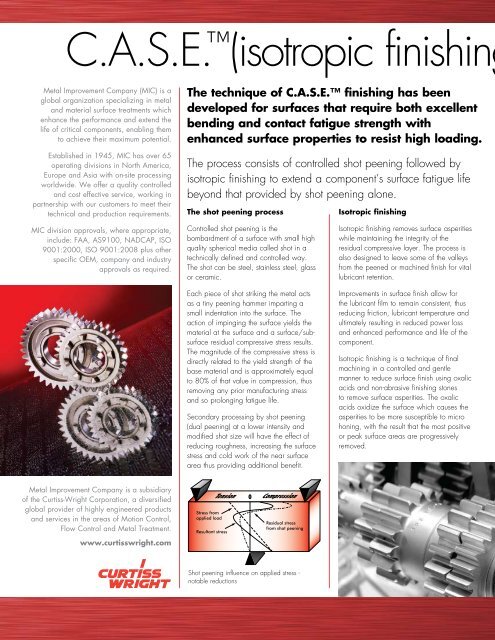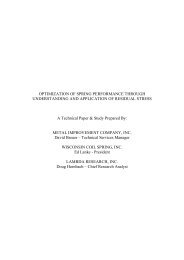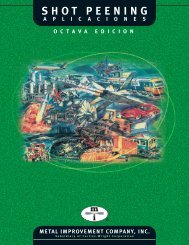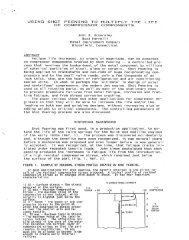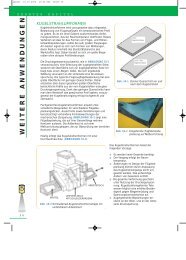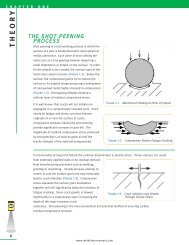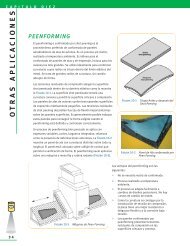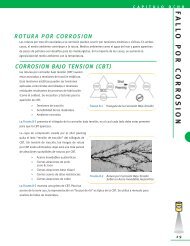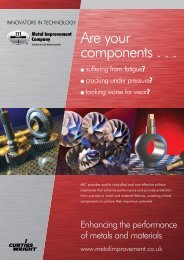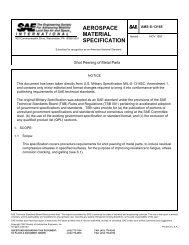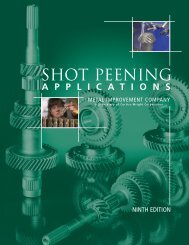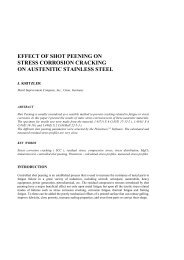Case Isotropic Finishing.pdf - Metal Improvement Company
Case Isotropic Finishing.pdf - Metal Improvement Company
Case Isotropic Finishing.pdf - Metal Improvement Company
You also want an ePaper? Increase the reach of your titles
YUMPU automatically turns print PDFs into web optimized ePapers that Google loves.
c.a.s.e. (isotropic finishing<br />
<strong>Metal</strong> <strong>Improvement</strong> <strong>Company</strong> (MIC) is a<br />
global organization specializing in metal<br />
and material surface treatments which<br />
enhance the performance and extend the<br />
life of critical components, enabling them<br />
to achieve their maximum potential.<br />
Established in 1945, MIC has over 65<br />
operating divisions in North America,<br />
Europe and Asia with on-site processing<br />
worldwide. We offer a quality controlled<br />
and cost effective service, working in<br />
partnership with our customers to meet their<br />
technical and production requirements.<br />
MIC division approvals, where appropriate,<br />
include: FAA, AS9100, NADCAP, ISO<br />
9001:2000, ISO 9001:2008 plus other<br />
specific OEM, company and industry<br />
approvals as required.<br />
<strong>Metal</strong> <strong>Improvement</strong> <strong>Company</strong> is a subsidiary<br />
of the Curtiss-Wright Corporation, a diversified<br />
global provider of highly engineered products<br />
and services in the areas of Motion Control,<br />
Flow Control and <strong>Metal</strong> Treatment.<br />
www.curtisswright.com<br />
The technique of C.A.S.E. finishing has been<br />
developed for surfaces that require both excellent<br />
bending and contact fatigue strength with<br />
enhanced surface properties to resist high loading.<br />
the process consists of controlled shot peening followed by<br />
isotropic finishing to extend a component’s surface fatigue life<br />
beyond that provided by shot peening alone.<br />
The shot peening process<br />
controlled shot peening is the<br />
bombardment of a surface with small high<br />
quality spherical media called shot in a<br />
technically defined and controlled way.<br />
the shot can be steel, stainless steel, glass<br />
or ceramic.<br />
each piece of shot striking the metal acts<br />
as a tiny peening hammer imparting a<br />
small indentation into the surface. the<br />
action of impinging the surface yields the<br />
material at the surface and a surface/subsurface<br />
residual compressive stress results.<br />
the magnitude of the compressive stress is<br />
directly related to the yield strength of the<br />
base material and is approximately equal<br />
to 80% of that value in compression, thus<br />
removing any prior manufacturing stress<br />
and so prolonging fatigue life.<br />
secondary processing by shot peening<br />
(dual peening) at a lower intensity and<br />
modified shot size will have the effect of<br />
reducing roughness, increasing the surface<br />
stress and cold work of the near surface<br />
area thus providing additional benefit.<br />
Stress from<br />
applied load<br />
Resultant stress<br />
Tension Compression<br />
Residual stress<br />
from shot peening<br />
shot peening influence on applied stress -<br />
notable reductions<br />
0<br />
<strong>Isotropic</strong> finishing<br />
<strong>Isotropic</strong> finishing removes surface asperities<br />
while maintaining the integrity of the<br />
residual compressive layer. the process is<br />
also designed to leave some of the valleys<br />
from the peened or machined finish for vital<br />
lubricant retention.<br />
<strong>Improvement</strong>s in surface finish allow for<br />
the lubricant film to remain consistent, thus<br />
reducing friction, lubricant temperature and<br />
ultimately resulting in reduced power loss<br />
and enhanced performance and life of the<br />
component.<br />
<strong>Isotropic</strong> finishing is a technique of final<br />
machining in a controlled and gentle<br />
manner to reduce surface finish using oxalic<br />
acids and non-abrasive finishing stones<br />
to remove surface asperities. the oxalic<br />
acids oxidize the surface which causes the<br />
asperities to be more susceptible to micro<br />
honing, with the result that the most positive<br />
or peak surface areas are progressively<br />
removed.


